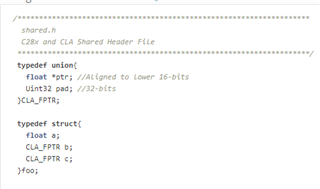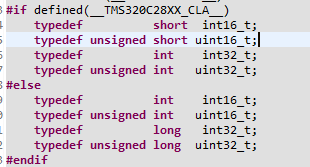I have a question regarding the shared variables used in both my CPU and CLA code.
I define these shared variables in a header file, which is included in both my CPU and CLA files. However, there is a discrepancy in how pointers are interpreted between the CPU and the CLA.
The CLA interprets pointers as 16 bits, whereas the CPU interprets them as 22 bits. This has led me to consider padding the pointers used by both the CPU and the CLA.
My main query is whether I need to pad every pointer that is shared between the CPU and the CLA?

Furthermore, the CLA interprets variables as 32 bits and does not recognize 16-bit variables. Does this mean that every variable shared between the CLA and the CPU needs to be at least 32 bits in size?
Lastly, I would appreciate clarification on whether the datatype size_t can be safely used on the CLA. My understanding is that the CPU interprets size_t as 16 bits, whereas the CLA interprets it as 32 bits.
Thank you for your assistance.
Regards,
Wilko


